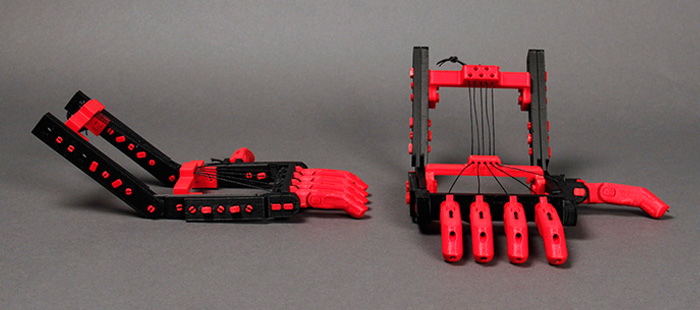
Robohand was a step forward for inexpensive prosthetic design. Courtesy of MakerBot.
Latest News
May 29, 2015
It’s sometimes hard to spot the changes wrought by new technology, but that isn’t the case for additive manufacturing (AM). While many 3D printed parts may be hidden away inside an airplane or automobile, it isn’t hard to find 3D printed objects that are making a difference in people’s lives, if you know where to look.
The field of prosthetics has been shaken up by AM in a thorough enough fashion for the technology to warrant its oft-used “disruptive” description. In place of prosthetics that cost thousands of dollars, AM has made it possible to produce prosthetics for tens of dollars. Recently, Google has made it possible for more people to gain access to a prosthetic hand by donating $600,000 to Enable.
 Robohand was a step forward for inexpensive prosthetic design. Courtesy of MakerBot.
Robohand was a step forward for inexpensive prosthetic design. Courtesy of MakerBot.A little over two years ago, Rapid Ready reported on a child that had received the gift of a 3D printed prosthetic hand from an unlikely partnership between a South African carpenter and a PLC Programmer/automation technician living in Washington. Further collaboration on their part resulted in an improved prosthetic design, which they called Robohand.
Those early steps, and the fact that the digital plans for the prosthetics hands were shared via the Internet, eventually led to the founding of Enable (or e-Nable). The group is connected by the Internet, and by a desire to improve the lives of those who require prosthetic hands. The community has designed a variety of prosthetics, and Enable offers them for free to those in need.
Of course, printing out and fitting someone for a prosthetic hand is a little more difficult than just buying the required materials (which cost about $35). Each individual user requires tweaks to the design or to the finished product to ensure comfort and usability. The Enable community assists new users either directly or by way of online communications to ensure each new prosthetic works as well as possible.
Inexpensive prosthetics are one of the best examples of how AM can shake up an industry. Below you’ll find a video about Enable.
Source: Enable
Subscribe to our FREE magazine, FREE email newsletters or both!
Latest News
About the Author
John NewmanJohn Newman is a Digital Engineering contributor who focuses on 3D printing. Contact him via [email protected] and read his posts on Rapid Ready Technology.
Follow DE





